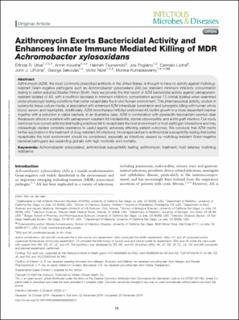| dc.description.abstract | Azithromycin (AZM), the most commonly prescribed antibiotic in the United States, is thought to have no activity against multidrug-resistant Gram-negative pathogens such as Achromobacter xylosoxidans (AX) per standard minimum inhibitory concentration testing in cation-adjusted Mueller Hinton Broth. Here we provide the first report of AZM bactericidal activity against carbapenem-resistant isolates of AX, with a multifold decrease in minimum inhibitory concentration across 12 clinical isolates when examined under physiologic testing conditions that better recapitulate the in vivo human environment. This pharmaceutical activity, evident in eukaryotic tissue culture media, is associated with enhanced AZM intracellular penetration and synergistic killing with human whole blood, serum, and neutrophils. Additionally, AZM monotherapy inhibited preformed AX biofilm growth in a dose-dependent manner together with a reduction in viable bacteria. In an illustrative case, AZM in combination with piperacillin-tazobactam exerted clear therapeutic effects in a patient with carbapenem-resistant AX mediastinitis, sternal osteomyelitis, and aortic graft infection. Our study reinforces how current antimicrobial testing practices fail to recapitulate the host environment or host-pathogen interactions and may misleadingly declare complete resistance to useful agents, adversely affecting patient outcomes. We conclude that AZM merits further exploration in the treatment of drug-resistant AX infections. Novel approaches to antimicrobial susceptibility testing that better recapitulate the host environment should be considered, especially as infections caused by multidrug-resistant Gram-negative bacterial pathogens are expanding globally with high morbidity and mortality. | |
